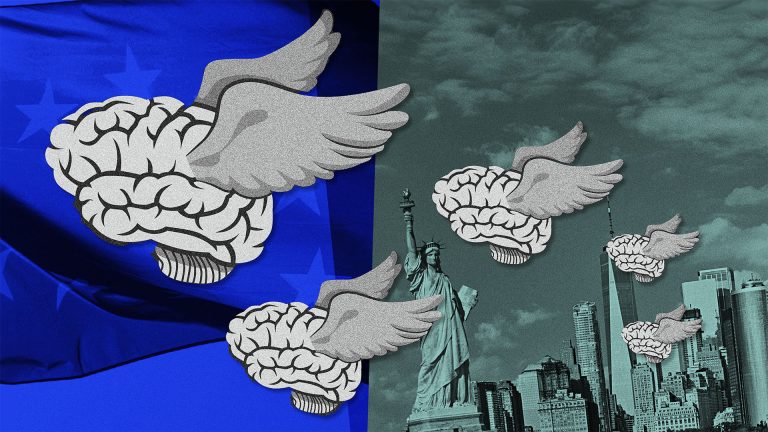Max Ernst was a “magician of infinite possibilities”. His paintings combine menace with mischief, grotesque apparitions that creep and crawl from swirls of discordant colours, peopled by humans with beaks for heads, and flamboyant females.
He created abstract works using a technique he called frottage – dropping sheets of paper on floor boards and rubbing them with charcoal to transfer the pattern of the grain to the paper. He made fantastical “novels”, collages that juxtaposed the ordinary in absurd and disturbing ways. He experimented with drip-painting, which inspired Jackson Pollock. He even sculpted whimsical bronze statuettes as quirky as characters in a Pixar movie, to be handed out as film awards.
So what to make of Ernst (1891-1976), dadaist, surrealist, and restless inventor of art forms that shock, challenge and delight? It is hard to argue with the American expressionist Robert Motherwell (1915-1991), who declared: “Like every consequential modern painter, Max Ernst has enforced his own madness on the world.”
That marvellous madness is on display in all its baffling complexities in Max Ernst: Surrealismo, Arte y Cine at Círculo de Bellas Artes in Madrid, which features more than 300 works including oil paintings, sculptures, collages and the frottages. But here the curators have chosen to emphasise his connection to cinema, the part he played in the making of films and how he even “starred” in the cinematic caprices of his contemporary surrealists.
The show opens as it means to go on with the (in)famous scene from Luis Buñuel’s 1929 film Un Perro Andaluz (aka Un Chien Andalou) in which an eyeball is meticulously sliced open. It is an allusion to the importance eyes played in Ernst’s work, which had its earliest sighting in 1922 when his image of a pierced eye was used for the cover of a book by his friend Paul Éluard.
A few years later, using frottage he made La Roue de la Lumiére (The Wheel of Light), a close up of an eye that seems to stare back at the viewer with unflinching intensity and is composed with a delicacy that seems impossible from such a simple art form.
He talked about eyes in an interview with the BBC in 1961, in which he explained how he kept one eye on the inner world and the other on reality and “came to a result which can be considered as the synthesis of objective and subjective life”. That requires quite a leap of imagination, but then it was always his aim to tease and discombobulate.
So much of Ernst’s vision of the world was born out of the tumult of the early 20th century, but nothing affected him more profoundly than his time as a soldier in the first world war. He wrote: “On the first of August 1914 M[ax].E[rnst]. died. He was resurrected on the eleventh of November 1918.”
And what a resurrection. After the war, traumatised and angry, he helped to form a dadaist group in Cologne and was soon swept up by the siren call of the surrealist movement, whose aim was to scandalise a repressed scout and shake the bourgeoisie out of its complacency.
In Paris, where he moved in 1922, he found himself in the company of other artistic disruptors such as Marc Chagall, Marcel Duchamp, Man Ray, Luis Buñuel, Salvador Dalí and Hans Richter, and welcomed the 1924 publication of the Surrealist Manifesto by André Breton with its rallying call for society to free itself from the constraints of the rational mind.
He had already demonstrated his ability to reach beyond the rational in 1919 with the first of his collages La Femme 100 Têtes, in which he collected 19th-century illustrations from magazines and catalogues and transformed them into stories of dreams and fantasy.
What to make of the running man, clutching his hat, an arm (someone else’s) strapped to his valise with the caption “Unpack your bag, mon brave?” A man and woman battling with enormous toucans, a recumbent woman, naked, spreadeagled before an organ? His own explanation: “Collage is the noble conquest of the irrational, the coupling of two realities.”
Many years later in 1967 the collages were transformed into film by Eric Duvivier, who stayed as close to original as possible though some of the interpretations were even more surreal, such as the phantasmic figures hovering over street scenes. Perhaps aware of Ernst’s dictum that “woman’s nudity is wiser than the philosopher’s teachings” the film seems more focused on naked women than the original.
Ernst, however, played a more significant role when he collaborated with Dalí and Buñuel on the film L’Age d’Or in 1930, which was a denunciation of religion, the constraining mores of the middle classes and an enthusiasm for the liberating effect of sexuality. It’s an odd affair, with Ernst playing a rather bedraggled bandit leader in scenes only tangentially connected to the main theme, the thwarted love affair between a couple who try anything and anywhere to consummate their passion, and peaking with our frustrated heroine kissing the toe of a garden statue in the absence of her amorato.
In 1947 Richter gathered together surrealist comrades such as Fernand Léger, Duchamp, Alexander Calder, as well as Ernst to make the film Dreams That Money Can Buy, in which an ordinary man named Joe discovers that he can see the contents of his mind when he looks into his eyes in the mirror (eyes again!) and realises that he can make dreams come true for a variety of neurotic clients.
Ernst wrote and directed the section entitled Desire, in which a wife bored by her bank clerk husband wants him to be more interesting, less inhibited, and earn more money. The clerk reveals that he has a collection of art images cut from magazines, including drawings of a woman in bed.
Joe finds him a dream: A woman in white reclines in a red-curtained four-poster bed, the man becomes part of her dream, they talk about “love and pleasure”.
This being the work of arch surrealists, she dreams of nightingales with calves’ hooves, a misty smoke envelops her bed, two young men start a fight. One of the men and a woman are pulled from underneath the bed by Ernst, sporting a sash like a French grandee, who then stealthily observes the shenanigans that follow.
The dream ends when the woman murmurs, again and again: “Who wants to come with me, under my warm white gown?”
The scene was taken from Ernst’s third collage novel, A Week of Kindness, based on the Bible story of the creation, with scenes of violence, suppressed erotic desires, blasphemy and death. Richter even used two of Ernst’s glaring eyes from the collages for the publicity poster.
Two of his best-known paintings appear on the walls in one scene of the film, though they can be easily missed in the chaos of the action. Happily, The Robing of the Bride (1940) and Lot’s Daughters (1943) are on show in all their gaudy glory.
In the former, a voluptuous creature draped in a garish orange cape of what could be thick feathers has the head of an owl with glaring eyes and the body of a woman naked from the breasts down but with a tiny head peering out between body and cape.
She could be based on Ernst’s lover at the time, Leonora Carrington, just as he could be identified as the long-beaked stork clutching a spear. Another naked woman with a swollen belly and streaming hair as if caught in a gale is pushed to one side, while an enigmatic green figure with four breasts and a penis sits on the floor.
In Lot’s Daughters, Ernst took the shocking Biblical story in which Lot and his two daughters flee the city of Sodom and take refuge in a cave. Believing that there were no men left alive, the two daughters commit incest with their father. Ernst portrays one with the boldness of a Las Vegas stripper with her torn red clothes and naked thigh, while the other skulks in the cave with her seemingly ashamed father, flashing her naked behind.
Ernst even made it to Hollywood when he entered a competition for a painting against fellow surrealists including Dalí, Carrington and Dorothea Tanning – then Ernst’s wife – to decorate the set of a 1947 film, The Private Affairs of Bel Ami, which starred George Sanders as a charming fraudster.
The result, which earned him $3,000 as the winner, was The Temptation of St. Anthony (1945). The painting depicts Anthony, who was known as the Father of Monks, in red robes that symbolise lust and desire, being tormented by demons. He is caught in the grip of a monster, beset by strange creatures with talons, beaks and fearsome gaping mouths. It is utterly disturbing, though the critic for the New York Times reckoned the figure looked “like a bad boiled lobster”.
It’s not clear why such a stunt was undertaken. The plot of the film had nothing to do with Anthony, who spent most of his life preaching in ancient Egypt.
But such incongruity would have appealed to Ernst. After all, as he insisted: “All good ideas arrive by chance.”
Max Ernst: Surrealismo, Arte y Cine at Círculo de Bellas Artes in Madrid, ends May 4











